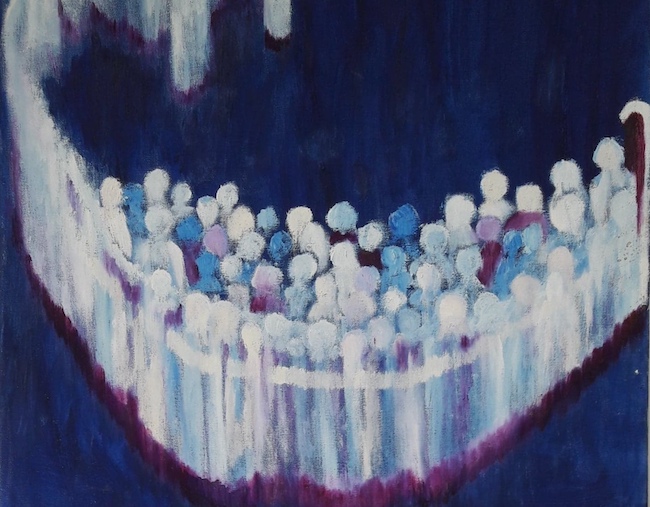L’approccio all’arte dei creativi del Ventunesimo secolo è molto spesso di tipo individualista, sia dal punto di vista del lasciar fuoriuscire le proprie emozioni, sia perché la società stessa tende costantemente verso un isolamento dell’essere umano, verso un graduale abbandono del senso di appartenenza a un gruppo, o a un a tribù, che invece aveva contraddistinto la vita dei secoli precedenti. Davanti a questo punto di vista l’artista si orienta spesso a sottolineare ed esplicitare il senso di solitudine che prima o poi emerge, quel chiudersi in se stesso dell’uomo e l’interiorizzare ogni tipo di emozione per superare da solo i propri disagi. La protagonista di oggi al contrario racconta di un mondo in cui il gruppo, la moltitudine, diviene una rassicurazione, la consapevolezza di poter tendere una mano trovandone un’altra che sarà sostegno e aiuto nel procedere insieme verso il futuro.
Quando agli inizi del Novecento l’Espressionismo cominciò ad affermarsi sospinto dall’esigenza di molti artisti di rivolgere lo sguardo più verso l’interno che non verso un esterno, un mondo formale troppo spesso asettico e lontano dai moti dell’animo che invece divennero predominanti in un periodo in cui le certezze precedenti si stavano sgretolando, il punto di vista con cui approcciavano la tela era prevalentemente soggettivo, avvolgendo dunque le tele delle loro interpretazioni emozionali e rivolgendo spesso le proprie attenzioni a un soggetto specifico di cui immortalare i pensieri, le ansie, le paure, le angosce. Raccontare quel mondo interiore che inevitabilmente apparteneva, e appartiene, all’essere umano era l’imperativo di grandi maestri espressionisti come Vincent Van Gogh, Egon Schiele, Emil Nolde, Edvard Munch, Ernst Ludwig Kirchner, August Macke, i quali diedero vita a stili personali, spesso estremamente differenti tra loro eppure tutti in grado di infondere nell’osservatore quelle sensazioni, quel magnetico coinvolgimento che nulla aveva a che vedere con lo sguardo verso il bello dei secoli precedenti. Mentre Vincent Van Gogh rimase molto legato a una rappresentazione fortemente figurativa attraverso la quale esternava il suo sguardo verso la natura, verso gli oggetti che circondavano la sua esistenza, il suo mondo fatto di ingenuità e di follia, Egon Schiele, anch’egli decisamente orientato a un approccio descrittivo, optò per la descrizione di un se stesso ossessionato dalla sensualità per sopravvivere alle angosce e alle inquietudini di un periodo di guerre mondiali e di perdita di ogni certezza se non quella delle proprie pulsioni. Edvard Munch si concentrò invece sul senso più profondo di ciò che percepiva dall’esterno, mettendo in secondo piano la realtà osservata, al ricercare una forma che l’occhio conosceva, perché in fondo per sentire non era necessario vedere, scorgere. Ma fu August Macke ad aprire le porte a un tipo di figurazione stilizzata, quasi priva di particolari nella descrizione dei volti per evidenziare l’essenza dei personaggi protagonisti, narrante il bisogno di socialità dell’uomo dell’epoca, quegli spazi di condivisione e di convivialità necessari all’essere umano per sentirsi parte di un gruppo, per sentirsi meno solo; dunque nel caso specifico dell’artista tedesco vi fu un ritorno all’esterno, non più solo un’interrogazione introspettiva ed esplorativa delle pulsioni intime, del disagio interiore, delle ansie e delle paure palesata nelle opere di Munch, bensì un desiderio di trovare nella moltitudine, nel gruppo, un modo per alleviarle le sensazioni che inevitabilmente accompagnano l’uomo e il suo percorso nella vita. L’artista norvegese Rønnaug Stjernen fa suo proprio il tema tanto caro a Macke, seppur modificandolo secondo il suo personale pensiero filosofico e approccio pittorico, quello appunto della comunità intesa come sostegno, come capacità di guardare verso la stessa direzione per perseguire obiettivi comuni, per costituire un insieme con cui muoversi e creare quella rete fondamentale all’essere umano per non sentirsi isolato, perduto, senza appigli.
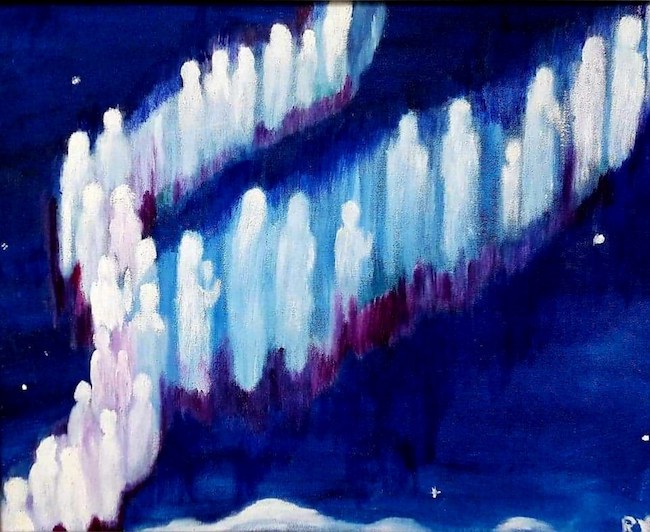
La gamma cromatica della Stjernen è meno Fauves rispetto a quella di Macke, più sfumata, più tendente in alcune opere addirittura a una bicromia in cui gli uomini, la moltitudine, vengono tratteggiati con il colore bianco e con le varie gradazioni della tonalità predominante del fondo che si accorda, a sua volta, alla sensazione da cui l’artista parte nel momento in cui si pone davanti alla tela.
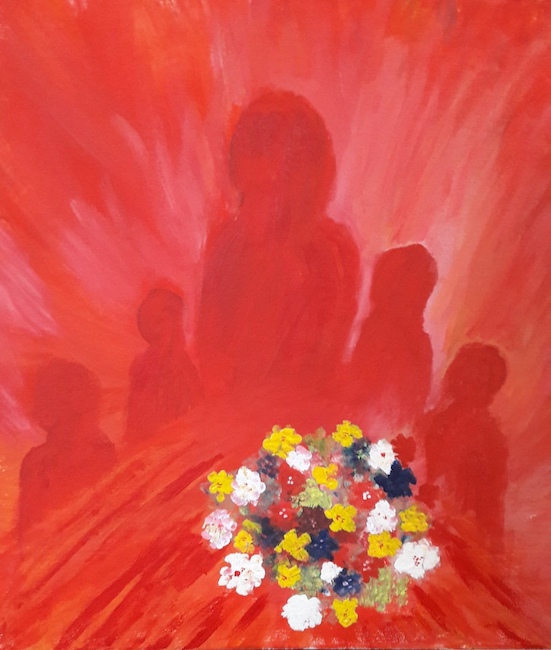
Tuttavia, osservando con maggiore attenzione le sue opere, non si può non percepire un orientamento molto spirituale, quasi ultraterreno, come se tutte le persone che riempiono i suoi dipinti fossero in realtà anime che aleggiano intorno all’essere umano, che lo proteggono e in qualche modo lo guidano, come se la loro presenza fosse essenziale per generare un’atmosfera avvolgente e morbida intorno alla realtà.
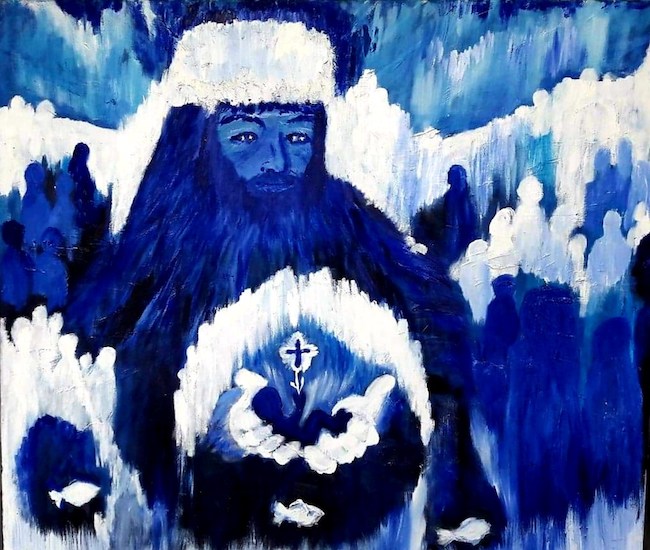
La religiosità, il legame con il divino, emerge delicatamente e poeticamente, quasi sussurrata perché è quello il punto di vista di Rønnaug Stjernen, un rapporto intimo, consapevole e dunque senza bisogno di emergere in maniera netta e nitida, non è necessario se si è in grado di ascoltare le energie che ruotano intorno all’individuo; eppure quella presenza soprannaturale è orientamento, è punto di riferimento per la capacità dell’uomo di credere in se stesso, di avere fiducia nel suo poter costruire un mondo migliore in cui tutto può divenire armonia.
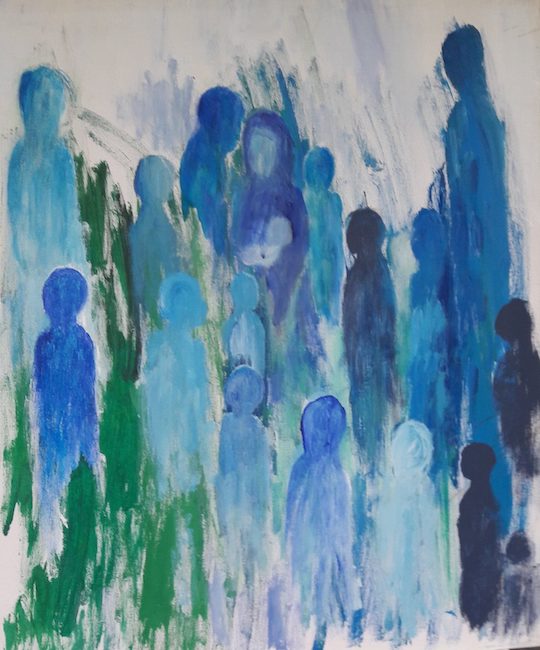
Il rapporto con la collettività è essenziale nel cammino pittorico della Stjernen, ed emerge in maniera chiara dall’opera Family walk che racconta di una donna con un bambino in braccio e degli affetti che le si stringono intorno per celebrare il lieto evento; l’artista gioca con il dualismo poiché la sensazione è quella che si tratti di una celebrazione della Madonna che gioisce insieme alle persone del villaggio della nascita di Gesù, eppure in quella mancanza di un dettaglio si possono ritrovare molte donne, madri, che hanno avuto l’opportunità di donare la vita, di generare un altro individuo che potrà contribuire al miglioramento del mondo se continuerà a essere circondato dalle radici, dagli affetti e dall’amore in grado di rendere chiunque una persona migliore.
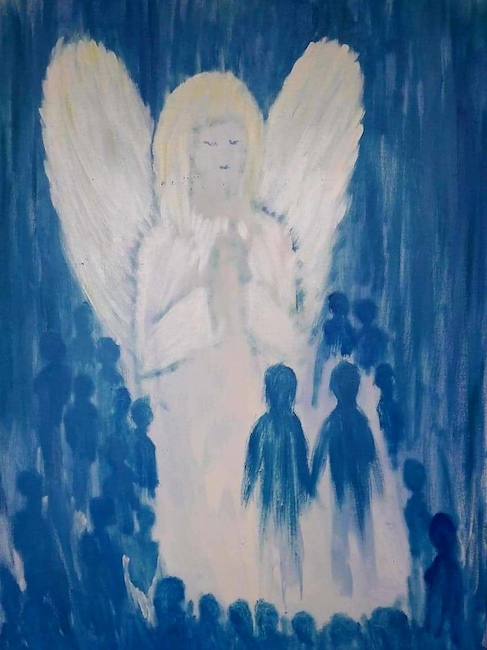
Nella tela My two brothers emerge ancor più il rapporto con la religiosità che Rønnaug Stjernen vive come parte sostanziale della sua esistenza, come una dimensione in cui si sente calata costantemente e protetta dalle anime che hanno fatto parte in qualche modo del suo cammino; in questo caso rivela il suo contatto con un angelo custode di cui evidenzia la posizione di preghiera, di raccoglimento e di sacralità nei confronti di tutte le persone sottostanti in generale e delle due in evidenza in particolare, come se la pittrice volesse affidare due figure per lei importanti, i suoi fratelli, alla protezione divina di chi se ne può prendere cura dal punto di vista spirituale. Il tema del sostegno, della tutela da parte della fede, del legame con quel divino troppo spesso trascurato nella società contemporanea è una costante nella produzione pittorica della Stjernen che ne fa non solo un tratto distintivo del suo Espressionismo, ma anche una pietra miliare di un’esistenza che non può sussistere senza l’appoggio della religiosità e della comunità, intesa come gruppo di persone che convivono e che insieme costruiscono le basi per un nuovo futuro poggiandosi sulla fiducia nei confronti di un passato che fa costantemente parte della loro vita presente.
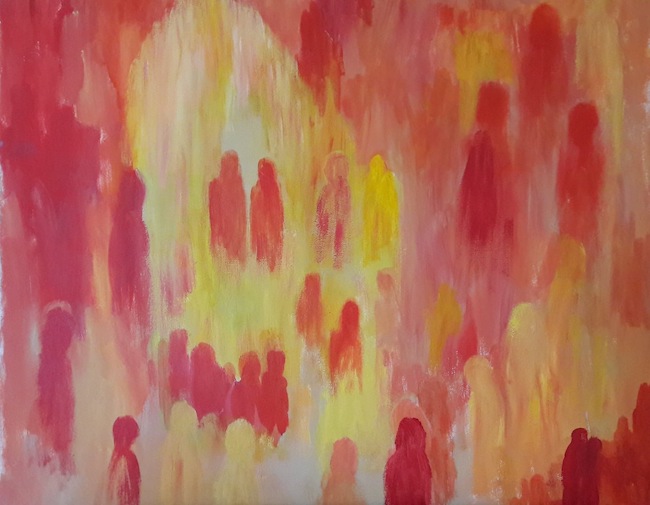
Ecco dunque che la tela Where we go 1 we go all assume il senso della consapevolezza, della coscienza collettiva e dell’attenzione nei confronti delle proprie azioni, intese come direzioni intraprese come umanità tutta, perché è proprio dai passi che verranno mossi in modo corale che sarà decretato un domani comune che può essere positivo o negativo sulla base delle scelte che si compiranno. In questa tela la tonalità non è in scala di blu come nelle precedenti bensì l’artista sceglie colori più caldi come il giallo, il rosso, l’arancio, gradazioni che sottintendono una gioiosità, un auspicio di essere in grado di intraprendere il cammino migliore, quello che condurrà a un’evoluzione e non a un’involuzione.
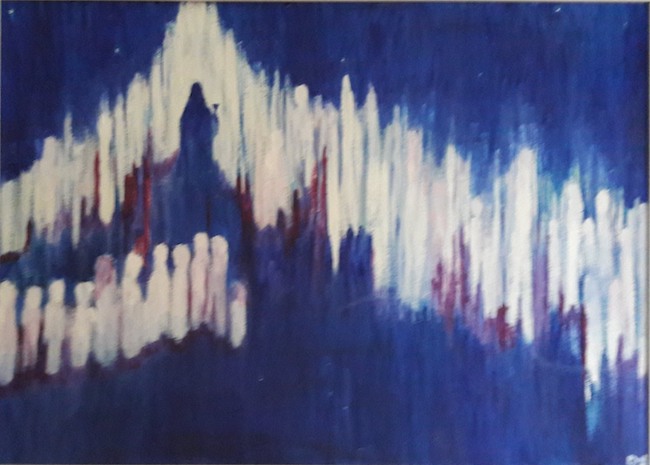
Rønnaug Stjernen si forma da autodidatta perché sente di avere dentro di sé ciò di cui ha bisogno per manifestare la sua sensibilità e il suo istinto creativo; ha all’attivo la partecipazione ad alcune mostre collettive e personali in Norvegia ma è solo negli ultimi due anni che ha deciso di far conoscere la sua arte anche all’estero prendendo parte a collettive in Italia, a Pesaro, Milano e Venezia.
RØNNAUG STJERNEN-CONTATTI
Email: rstjernen@yahoo.no
Facebook: https://www.facebook.com/rstjernen
Instagram: https://www.instagram.com/rstjernen/
The spiritual and reassuring power of the multitude in Rønnaug Stjernen’s evocative Expressionism
Twenty-first-century artists often take an individualistic approach to art, both from the point of view of letting their emotions out and because society itself tends to isolate human beings, gradually abandoning the sense of belonging to a group or tribe that had characterised life in previous centuries. Faced with this point of view, the artist often emphasises and explains the sense of loneliness that sooner or later emerges, man’s withdrawal into himself and the internalisation of every type of emotion in order to overcome his discomfort alone. Today’s protagonist, on the contrary, tells of a world in which the group, the multitude, becomes a reassurance, the awareness of being able to extend a hand and find another that will be a support and help in moving forward together towards the future.
When, at the beginning of the 20th century, Expressionism began to assert itself, driven by the need of many artists to look more inwards than outwards, a formal world too often aseptic and far removed from the motions of the soul that instead became predominant at a time when previous certainties were crumbling, the point of view with which they approached the canvas was predominantly subjective, thus wrapping the canvases in their emotional interpretations and often turning their attention to a specific subject whose thoughts, anxieties, fears and anguishes they immortalised. Telling that inner world that inevitably belonged, and still belongs, to the human being was the imperative of great expressionist masters such as Vincent Van Gogh, Egon Schiele, Emil Nolde, Edvard Munch, Ernst Ludwig Kirchner and August Macke, who created personal styles, often extremely different from each other but all capable of instilling in the observer those sensations, that magnetic involvement that had nothing to do with the gaze towards beauty of previous centuries. While Vincent Van Gogh remained very attached to a strongly figurative representation through which he expressed his gaze towards nature, towards the objects that surrounded his existence, his world made up of naivety and madness, Egon Schiele, who was also decidedly oriented towards a descriptive approach, opted for the description of a self obsessed by sensuality in order to survive the anguish and anxiety of a period of world wars and the loss of all certainty except that of his own pulsions. Edvard Munch, on the other hand, concentrated on the deeper meaning of what he perceived from the outside, putting the observed reality in the background, in search of a form that the eye knew, because in the end it was not necessary to see or glimpse in order to feel.
But it was August Macke who opened the doors to a type of stylised figuration, almost devoid of detail in the description of faces to highlight the essence of the protagonists, narrating the need for sociality of man at the time, those spaces for sharing and conviviality necessary for the human being to feel part of a group, to feel less alone; in the specific case of the German artist, therefore, there was a return to the outside world, no longer just an introspective and exploratory questioning of intimate drives, inner unease, anxieties and fears manifested in Munch’s artworks, but a desire to find in the multitude, in the group, a way of alleviating the feelings that inevitably accompany man and his journey through life. The Norwegian artist Rønnaug Stjernen takes up the theme so dear to Macke, albeit modifying it according to her own personal philosophical thinking and pictorial approach, that of the community understood as support, as the capacity to look in the same direction to pursue common goals, to form a whole with which to move and create that network which is fundamental to human beings in order not to feel isolated, lost, without footholds. Stjernen’s chromatic range is less Fauves than Macke’s, more nuanced, tending in some paintings towards a two-tone colour scheme in which the men, the multitude, are outlined in white and in the various shades of the predominant colour of the background, which in turn matches the sensation from which the artist starts when he stands in front of the canvas. However, looking more closely at her artworks, one cannot fail to perceive a very spiritual, almost otherworldly orientation, as if all the people who fill her paintings were actually souls hovering around the human being, protecting and in some way guiding him, as if their presence were essential to generate an enveloping, soft atmosphere around reality. Religiousness, the bond with the divine, emerges delicately and poetically, almost whispered because that is Rønnaug Stjernen’s point of view, an intimate relationship, conscious and therefore without the need to emerge clearly and distinctly, it is not necessary if one is able to listen to the energies that revolve around the individual; yet that supernatural presence is orientation, it is a point of reference for man’s ability to believe in himself, to have faith in his ability to build a better world in which everything can become harmony. The relationship with the community is essential in Stjernen’s pictorial journey, and it emerges clearly from the artwork Family walk, which tells of a woman with a baby in her arms and the affections that gather around her to celebrate the happy event; the artist plays with dualism, as the sensation is that it is a celebration of the Madonna rejoicing with the people of the village at the birth of Jesus, yet in that lack of detail we can find many women, mothers, who have had the opportunity to give life, to generate another individual who can contribute to the improvement of the world if he continues to be surrounded by the roots, affection and love that can make everyone a better person.
In the canvas My two brothers, the relationship with religiosity emerges even more, which Rønnaug Stjernen experiences as a substantial part of her existence, as a dimension where she feels constantly immersed and protected by the souls that have in some way been part of her path; in this case, she reveals her contact with a guardian angel, of which she underlines his position of prayer, recollection and sacredness towards all the people below in general and the two highlighted in particular, as if the painter wished to entrust two figures that are important to her, her brothers, to the divine protection of someone who can take care of them from a spiritual point of view. The theme of support, of protection by faith, of the link with the divine, too often neglected in contemporary society, is a constant in Stjernen’s painting, which she makes not only a distinctive feature of her Expressionism, but also a milestone in an existence that cannot exist without the support of religion and community, understood as a group of people living together who build the foundations for a new future based on trust in a past that is constantly part of their present life. Thus, the canvas Where we go 1 we go all takes on the meaning of awareness, collective consciousness and attention to one’s own actions, understood as the directions taken by humanity as a whole, because it is precisely from the steps that will be taken together that a common tomorrow will be decreed, which can be positive or negative depending on the choices that will be made. In this painting, the tone is not a scale of blue as in the previous ones, but the artist chooses warmer colours such as yellow, red and orange, shades that imply a joyfulness, a wish to be able to take the best path, the one that will lead to evolution and not to involution. Rønnaug Stjernen trained as a self-taught artist because she feels she has what she needs within her to express her sensitivity and creative instinct; she has taken part in several group and solo exhibitions in Norway but it is only in the last two years that she has decided to make her art known abroad by taking part in group exhibitions in Italy, in Pesaro, Milan and Venice.


